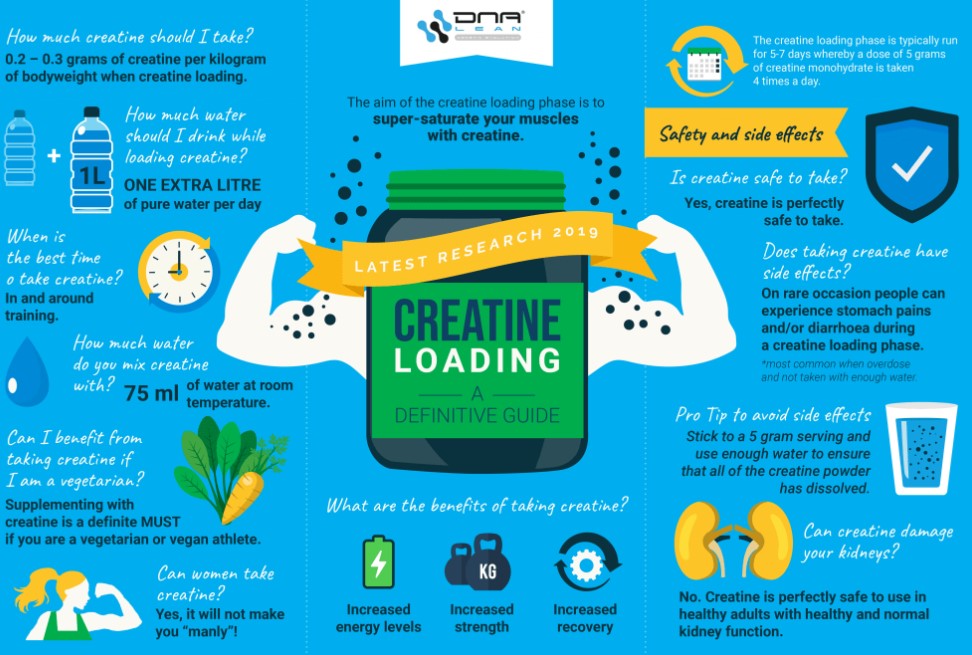BOURSESSENEGAL – If you’re considering enhancing your athletic performance or boosting your muscle gains, you’ve likely come across the creatine loading phase. This strategy has garnered attention for its potential benefits in quickly saturating your muscles with creatine. In this comprehensive guide, we’ll delve into what the loading phase is, its benefits, potential side effects, and how to effectively implement it.
What is Creatine?
Understanding Creatine
Creatine is a naturally occurring compound found in small amounts in certain foods and synthesized in the body from amino acids. It plays a vital role in energy production, particularly during high-intensity exercise. Supplementing with creatine has become popular among athletes and fitness enthusiasts looking to enhance their performance and increase muscle mass.
Types of Creatine
Several forms of creatine are available on the market, with creatine monohydrate being the most studied and widely used. Other types include creatine ethyl ester, buffered creatine, and micronized creatine. While the loading phase is most commonly associated with creatine monohydrate, understanding these types can help you choose the right supplement for your needs.
What is the Creatine Loading Phase?
Definition and Purpose
The creatine loading phase refers to the initial period when you take higher doses of creatine to rapidly increase the concentration of creatine in your muscles. Typically lasting about five to seven days, this phase involves consuming approximately 20 grams of creatine per day, divided into four doses.
The purpose of this phase is to saturate your muscles quickly, leading to faster results. After the loading phase, you switch to a maintenance dose of about 3 to 5 grams per day to keep your muscle creatine levels elevated.
How Does the Loading Phase Work?
During the loading phase, you flood your muscles with creatine. This process enhances your muscles’ phosphocreatine stores, which helps regenerate adenosine triphosphate (ATP) during short bursts of high-intensity exercise. The quicker you saturate your muscles, the sooner you can experience the performance benefits of creatine supplementation.
Benefits of the Creatine Loading Phase
Improved Athletic Performance
The primary benefit of the creatine loading phase is improved athletic performance. Research indicates that creatine can enhance strength, power, and endurance. By quickly increasing muscle creatine levels, you may notice:
- Increased strength: Enhanced performance during resistance training.
- Faster recovery: Reduced muscle fatigue and soreness post-exercise.
- Improved endurance: Enhanced performance during high-intensity, short-duration activities.
Enhanced Muscle Growth
Along with performance benefits, the creatine loading phase can contribute to muscle growth. Creatine promotes muscle protein synthesis, allowing for greater gains in lean muscle mass. Additionally, increased water retention in the muscles can lead to a fuller appearance.
Faster Results
Many users appreciate the quick results associated with the loading phase. By saturating your muscles with creatine in a short period, you may start to notice performance improvements within just a week. This aspect can be particularly appealing for those looking to make quick progress in their training.
How to Implement the Creatine Loading Phase
Dosage Guidelines
To effectively implement the creatine loading phase, follow these dosage guidelines:
- Loading Phase: Take approximately 20 grams of creatine per day for five to seven days. Split this into four doses of 5 grams each, ideally taken throughout the day.
- Maintenance Phase: After the loading phase, transition to a maintenance dose of 3 to 5 grams per day. This dose helps maintain elevated muscle creatine levels.
Timing and Administration
While creatine can be taken at any time, some studies suggest that taking it post-workout may enhance its effectiveness. Consider mixing creatine with a carbohydrate source (like a sports drink or juice) to increase absorption.
Hydration
During the loading phase, ensure you stay well-hydrated. Creatine draws water into your muscles, which can increase your risk of dehydration if fluid intake is insufficient. Aim to drink plenty of water throughout the day to support optimal hydration.
Potential Side Effects of the Creatine Loading Phase
Gastrointestinal Discomfort
Some individuals may experience gastrointestinal discomfort during the loading phase. This can include symptoms like bloating, cramping, or diarrhea. To mitigate these effects, consider spreading your doses throughout the day and taking creatine with food.
Weight Gain
Many users notice an increase in weight during the loading phase, primarily due to water retention in the muscles. While this weight gain is not fat, it can be surprising. Keep in mind that this increase is typically temporary and should stabilize once you enter the maintenance phase.
Kidney Concerns
There’s ongoing debate regarding creatine’s effects on kidney function. While research generally supports its safety in healthy individuals, those with pre-existing kidney conditions should consult a healthcare professional before beginning supplementation.
Alternatives to the Creatine Loading Phase
Skip the Loading Phase
If you prefer a more gradual approach, you can skip the loading phase entirely. Instead, take the maintenance dose of 3 to 5 grams daily. While this method takes longer to achieve saturation—around 3 to 4 weeks—it can still provide similar benefits without the initial higher dosage.
Cycling Creatine
Some athletes choose to cycle their creatine usage. This approach involves periods of supplementation followed by breaks. Cycling may help prevent potential downregulation of the body’s natural creatine production.
Conclusion
The creatine loading phase offers a fast-track method for athletes and fitness enthusiasts to enhance their performance and muscle growth. By saturating your muscles quickly with creatine, you can experience improved strength, power, and recovery in a short amount of time.
While the loading phase can provide significant benefits, it’s essential to be mindful of potential side effects, such as gastrointestinal discomfort and weight gain. If you choose to implement this strategy, ensure you stay hydrated and monitor how your body responds.
As with any supplement, individual responses can vary. If you have any health concerns or pre-existing conditions, consult with a healthcare professional before starting the creatine loading phase. With the right approach, you can maximize your workouts and achieve your fitness goals effectively.
REFERENCE : https://www.health.com/



